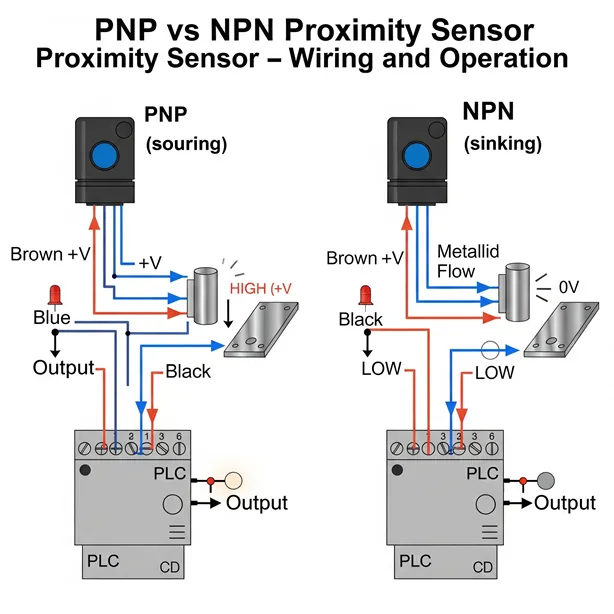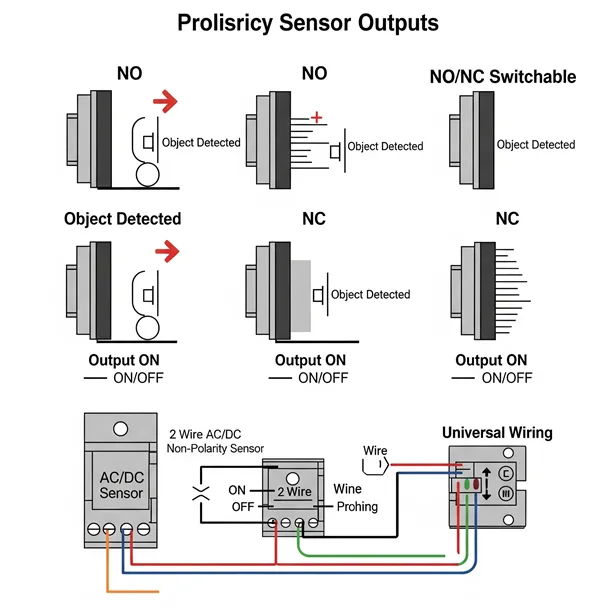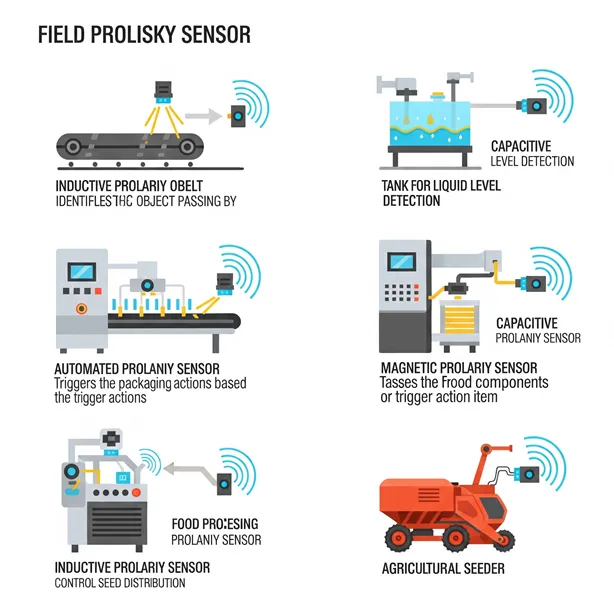PNP NPN Output Coanfiguration in Proximity Sensors – PNP, NPN, NO, NC Explained
Published on July 2, 2024 | Category: ProximityShare this Page:
A proximity sensor is a type of non-contact sensing device that detects the presence, absence, or movement of an object within its sensing range without any physical contact. Unlike mechanical limit switches, which rely on physical interaction with the target, proximity sensors generate an electrical signal when an object (also known as the 'target') enters their field of detection. These sensors operate based on several physical principles, such as electromagnetic induction (used in inductive sensors), changes in electrical capacitance (used in capacitive sensors), ultrasonic wave reflection, infrared light reflection, and magnetic field detection (reed switches).
Proximity sensors are widely used in industrial automation systems, robotics, safety systems, smart phones, packaging machinery, and automotive applications like self-driving vehicles. Depending on the type, they can detect both metallic and non-metallic objects and provide accurate, high-speed, and wear-free operation.
This page explains the core working principles of proximity sensors, their various types—inductive, capacitive, ultrasonic, photoelectric, and magnetic—their detection mechanisms, key features, sensing ranges, and practical applications. It also covers relevant global standards such as JIS C 8201-5-2 and IEC 60947-5-2, which define how proximity sensors are classified and tested. Understanding these concepts is essential for engineers, technicians, and automation professionals aiming to integrate smart and contactless detection systems into modern control processes.
What is Output Configuration in Proximity Sensors?
The output configuration of a proximity sensor defines how the sensor behaves when it detects a target. It includes two main parameters:
- Output Type: NPN (sinking) or PNP (sourcing)
- Output Function: NO (Normally Open) or NC (Normally Closed)
Output Type: PNP vs. NPN
- PNP (Sourcing): When activated, the sensor outputs positive voltage (+V). It “sources” current to the load or PLC input. Common in European systems.
- NPN (Sinking): When activated, the sensor output goes to ground (0V). It “sinks” current from the load to ground. Common in Asian systems.
Output Function: NO vs. NC
- Normally Open (NO): The output is OFF when no target is detected. It turns ON only when the object is detected.
- Normally Closed (NC): The output is ON when no target is detected. It turns OFF when the object is detected.
Combining Output Type and Function
Proximity sensors often come in combinations such as:
- PNP-NO: Sourcing output, normally OFF — goes HIGH (+V) when object is detected
- PNP-NC: Sourcing output, normally ON — goes LOW when object is detected
- NPN-NO: Sinking output, normally OFF — goes LOW (0V) when object is detected
- NPN-NC: Sinking output, normally ON — goes HIGH when object is detected

Choosing the correct output configuration is essential for proper sensor-to-controller communication. Make sure it matches your PLC or relay input logic to avoid unexpected behavior.
Proximity Sensor Output Types – NO, NC, and Non-Polarity Explained
Proximity sensors are available with different output configurations depending on the requirements of your control system. Understanding these output types helps in selecting the right sensor for reliable and safe operation.
1. Non-Polarity / Non-Contact Output (2-Wire Type)
Some proximity sensors are designed with a 2-wire non-polarized output that can work with both AC and DC power supplies. This eliminates the concern about reversing polarity during installation and simplifies wiring.
- Can be connected to either AC or DC circuits
- Suitable for applications where power type may vary
- Greatly reduces wiring errors
2. Output Functions – NO, NC, and Switchable
NO (Normally Open)
In a Normally Open (NO) proximity sensor, the output switching element remains OFF when no object is detected. When a target enters the sensing range, the output turns ON. This is the most common configuration.
- No object: Output is OFF
- Object detected: Output is ON
NC (Normally Closed)
In a Normally Closed (NC) sensor, the output is ON when no object is present. When an object is detected, the output turns OFF.
- No object: Output is ON
- Object detected: Output is OFF
NO/NC Switchable Output
Some proximity sensors offer a NO/NC switchable output, allowing the user to select the desired operation mode via a switch or configuration setting on the sensor body. This provides flexibility during installation and system design.
- Allows changing between NO and NC modes
- Ideal for multi-use or configurable systems
- Reduces the need to stock multiple sensor models

Key Terms in Proximity Sensors
Standard Sensing Object
A reference object (with specific material, shape, and size) used to measure sensor performance, such as sensing distance and accuracy.
Sensing Distance
The maximum distance at which the sensor can detect the standard sensing object. Measured from the sensor face to the target.
Set Distance
The recommended operating range (about 70–80% of rated sensing distance) for stable detection under varying temperature and voltage.
Rated Sensing Distance
The maximum distance the sensor can detect the standard object under ideal conditions.
Hysteresis
The difference between the sensor’s ON point (detection) and OFF point (reset). Prevents false switching due to small movements.
Response Time (t1 / t2)
- t1: Time from object detection to output ON.
- t2: Time from object leaving to output OFF.
Response Frequency
The number of detection cycles the sensor can perform per second (measured using repeated approach/removal of the object).
Shielded vs Unshielded Sensors
- Shielded: Magnetic field is focused forward. Can be flush-mounted in metal.
- Unshielded: Wider magnetic field. Longer sensing range but must avoid surrounding metal interference.
Proximity Sensor Classification and Selection Guide
Proximity sensors are classified based on their detection method and the type of object they can sense. The three most common types are Inductive, Capacitive, and Magnetic proximity sensors.

Sensor Selection by Detection Method
| Criteria | Inductive | Capacitive | Magnetic |
|---|---|---|---|
| Detection Target | Metals (iron, aluminum, copper, brass) | Metals, liquids, powders, resins, plastics | Magnets only |
| Noise Sensitivity | Affected by grounding, wiring, and EMI | Can be sensitive to long cables or noise | Minimal noise sensitivity |
| Power Supply | DC, AC, AC/DC, or non-polar DC types | Same as inductive | Same as inductive |
| Current Consumption | Varies (2-wire or 3-wire DC, AC) | DC 2-wire models reduce current draw | Similar consumption |
| Sensing Distance | Depends on material, temperature, mounting | Influenced by target size and dielectric constant | Fixed distance based on magnet strength |
| Ambient Conditions | Check IP rating for oil, water, and dust | Ensure compatibility with moisture or chemicals | Generally robust but check datasheet |
| Shock & Vibration | Requires stable mounting and torque control | Same as inductive | Ensure mechanical stability |
| Mounting Considerations | Must consider metal surroundings and spacing | Check for mutual interference and object effects | Less affected, but check mechanical space |
Tips for Sensor Selection
- Choose inductive sensors for metal-only detection with high reliability.
- Use capacitive sensors for detecting liquids, powders, or plastic.
- Select magnetic sensors where only magnetic targets are involved.
- Always verify environmental ratings (e.g. IP67) for harsh conditions.
- Account for vibration and proper tightening torque during installation.
Advantages of Proximity Sensors – Interview Points
Proximity sensors offer several key advantages over mechanical switches and optical sensors. These points are essential for interviews and technical discussions.
-
Non-contact Detection:
Proximity sensors detect the presence of an object without physical contact. This prevents wear, abrasion, or damage to sensitive targets—unlike mechanical switches. -
Longer Service Life:
They use semiconductor outputs instead of mechanical contacts, resulting in a longer operational life (except magnetic proximity sensors). -
Works in Harsh Environments:
Unlike optical sensors, proximity sensors are suitable for areas with oil, dust, or water. Special chemical-resistant models with fluororesin casings are also available. -
Fast Response Time:
Proximity sensors respond faster than contact-based sensors, making them ideal for high-speed detection in automation systems. -
Wide Temperature Range:
Many proximity sensors operate reliably in extreme temperatures, typically from −40°C to +200°C depending on the model. -
Color Independent Detection:
Since detection is based on physical or electrical properties (not color), proximity sensors are unaffected by the object's surface color. -
Mutual Interference and Surrounding Effects:
Sensors may interfere with each other if mounted too closely. Inductive sensors are affected by surrounding metal, and capacitive ones by any nearby material. Proper spacing and shielding are essential. -
Available in Two-Wire Versions:
Two-wire proximity sensors combine power and signal lines, simplifying wiring. However, a load must always be connected in series to prevent internal damage.
Note: Always refer to sensor datasheets and installation precautions to avoid errors due to mutual interference or improper wiring.